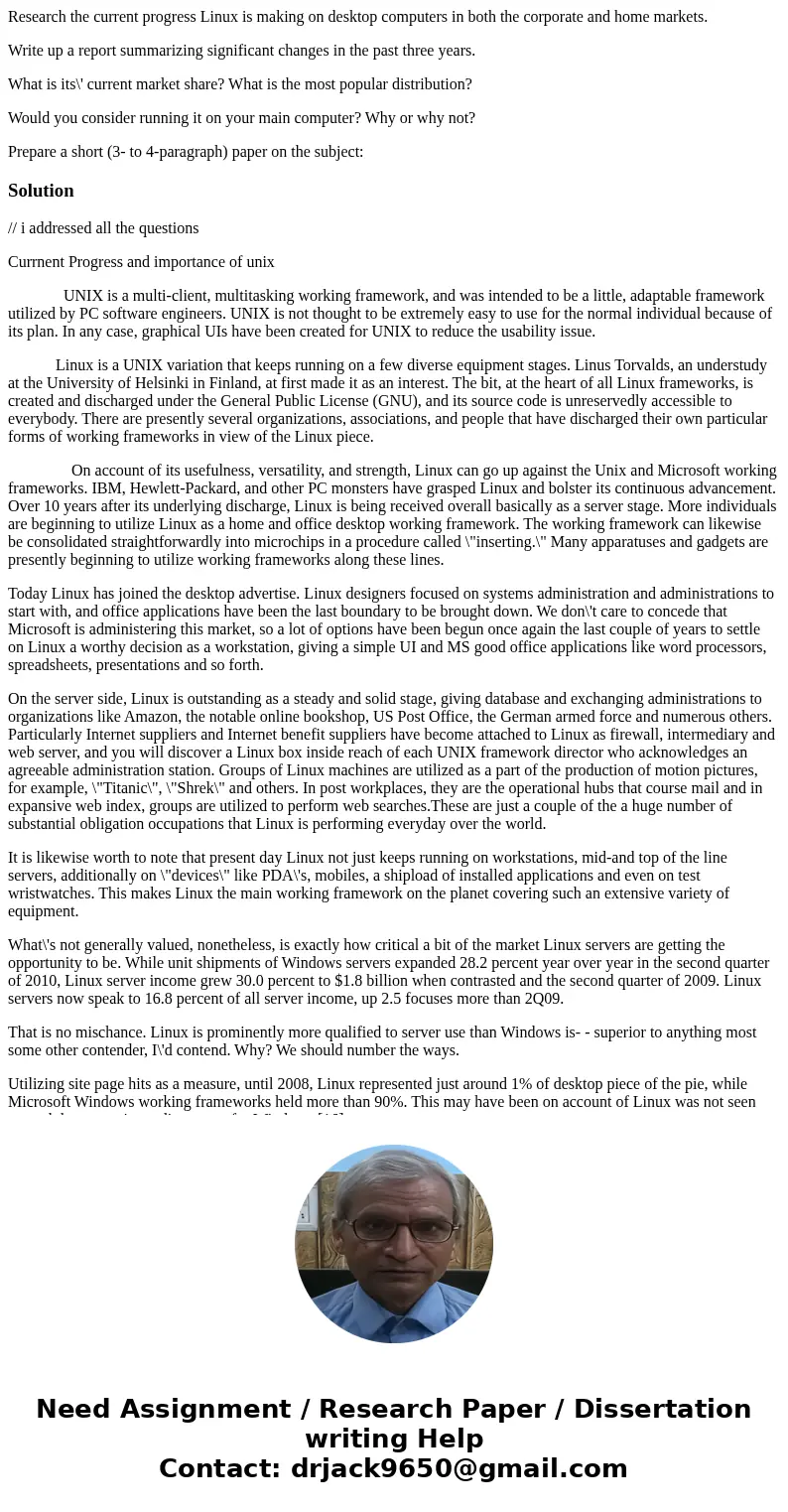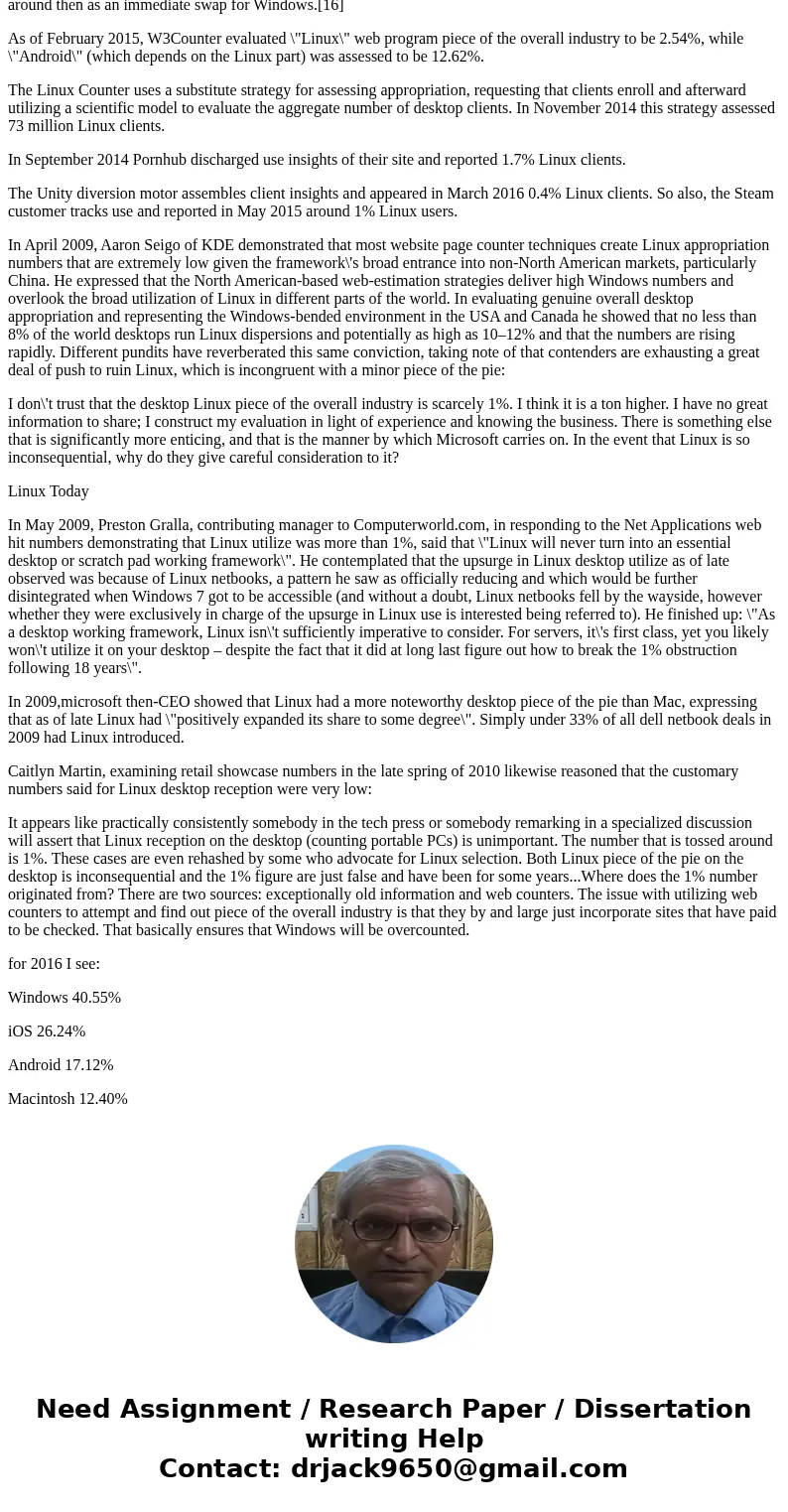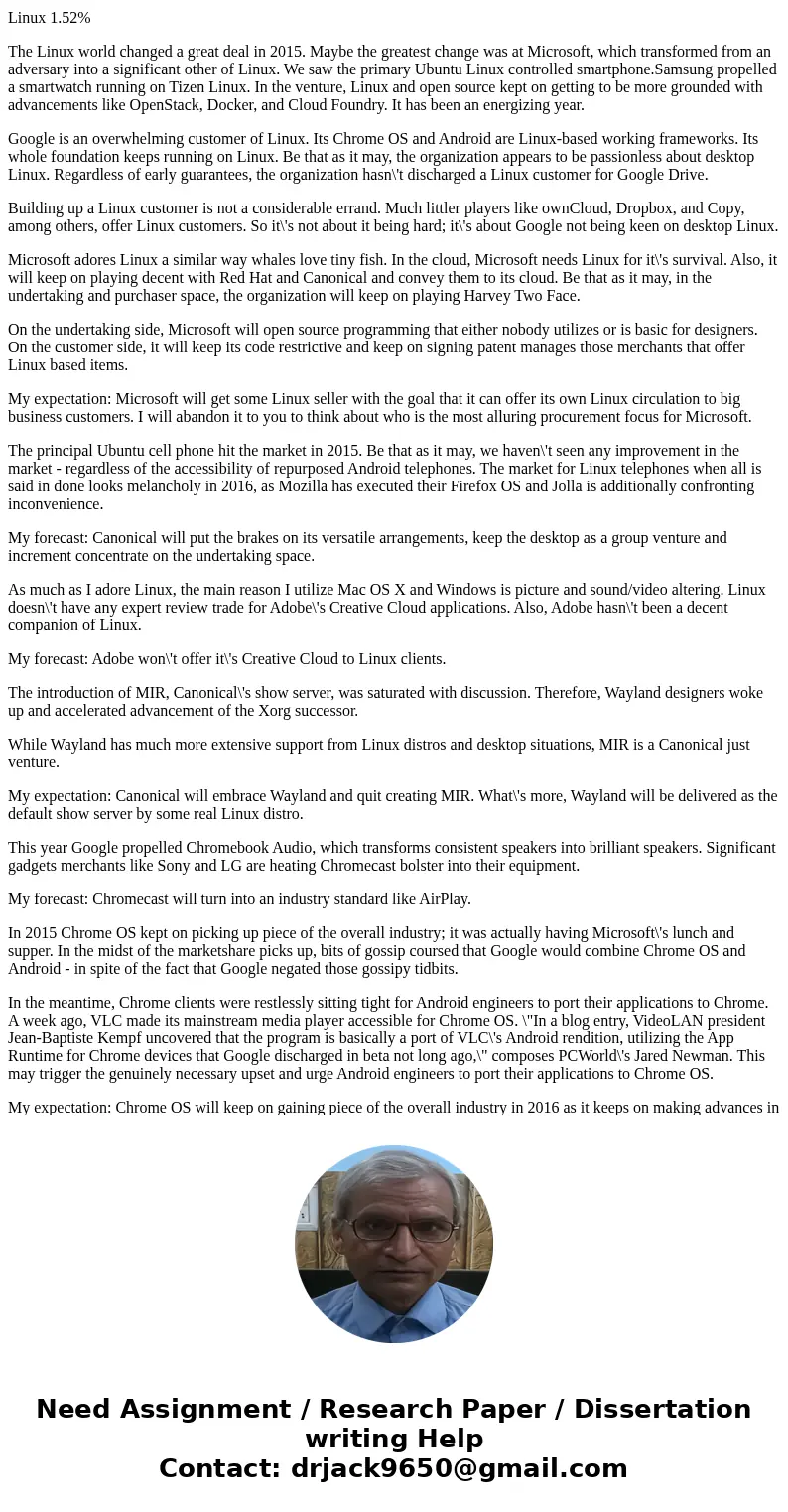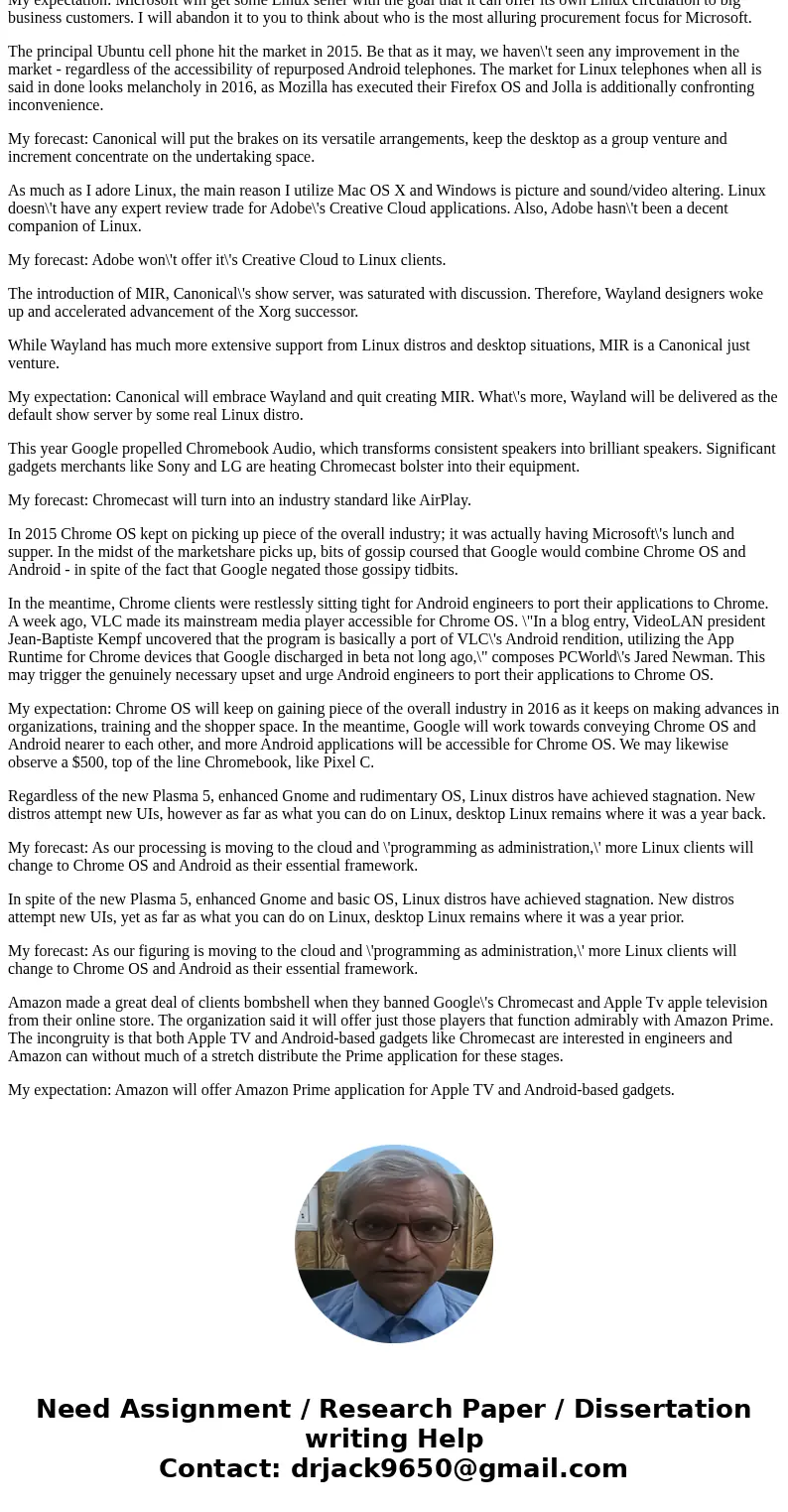Research the current progress Linux is making on desktop com
Research the current progress Linux is making on desktop computers in both the corporate and home markets.
Write up a report summarizing significant changes in the past three years.
What is its\' current market share? What is the most popular distribution?
Would you consider running it on your main computer? Why or why not?
Prepare a short (3- to 4-paragraph) paper on the subject:
Solution
// i addressed all the questions
Currnent Progress and importance of unix
UNIX is a multi-client, multitasking working framework, and was intended to be a little, adaptable framework utilized by PC software engineers. UNIX is not thought to be extremely easy to use for the normal individual because of its plan. In any case, graphical UIs have been created for UNIX to reduce the usability issue.
Linux is a UNIX variation that keeps running on a few diverse equipment stages. Linus Torvalds, an understudy at the University of Helsinki in Finland, at first made it as an interest. The bit, at the heart of all Linux frameworks, is created and discharged under the General Public License (GNU), and its source code is unreservedly accessible to everybody. There are presently several organizations, associations, and people that have discharged their own particular forms of working frameworks in view of the Linux piece.
On account of its usefulness, versatility, and strength, Linux can go up against the Unix and Microsoft working frameworks. IBM, Hewlett-Packard, and other PC monsters have grasped Linux and bolster its continuous advancement. Over 10 years after its underlying discharge, Linux is being received overall basically as a server stage. More individuals are beginning to utilize Linux as a home and office desktop working framework. The working framework can likewise be consolidated straightforwardly into microchips in a procedure called \"inserting.\" Many apparatuses and gadgets are presently beginning to utilize working frameworks along these lines.
Today Linux has joined the desktop advertise. Linux designers focused on systems administration and administrations to start with, and office applications have been the last boundary to be brought down. We don\'t care to concede that Microsoft is administering this market, so a lot of options have been begun once again the last couple of years to settle on Linux a worthy decision as a workstation, giving a simple UI and MS good office applications like word processors, spreadsheets, presentations and so forth.
On the server side, Linux is outstanding as a steady and solid stage, giving database and exchanging administrations to organizations like Amazon, the notable online bookshop, US Post Office, the German armed force and numerous others. Particularly Internet suppliers and Internet benefit suppliers have become attached to Linux as firewall, intermediary and web server, and you will discover a Linux box inside reach of each UNIX framework director who acknowledges an agreeable administration station. Groups of Linux machines are utilized as a part of the production of motion pictures, for example, \"Titanic\", \"Shrek\" and others. In post workplaces, they are the operational hubs that course mail and in expansive web index, groups are utilized to perform web searches.These are just a couple of the a huge number of substantial obligation occupations that Linux is performing everyday over the world.
It is likewise worth to note that present day Linux not just keeps running on workstations, mid-and top of the line servers, additionally on \"devices\" like PDA\'s, mobiles, a shipload of installed applications and even on test wristwatches. This makes Linux the main working framework on the planet covering such an extensive variety of equipment.
What\'s not generally valued, nonetheless, is exactly how critical a bit of the market Linux servers are getting the opportunity to be. While unit shipments of Windows servers expanded 28.2 percent year over year in the second quarter of 2010, Linux server income grew 30.0 percent to $1.8 billion when contrasted and the second quarter of 2009. Linux servers now speak to 16.8 percent of all server income, up 2.5 focuses more than 2Q09.
That is no mischance. Linux is prominently more qualified to server use than Windows is- - superior to anything most some other contender, I\'d contend. Why? We should number the ways.
Utilizing site page hits as a measure, until 2008, Linux represented just around 1% of desktop piece of the pie, while Microsoft Windows working frameworks held more than 90%. This may have been on account of Linux was not seen around then as an immediate swap for Windows.[16]
As of February 2015, W3Counter evaluated \"Linux\" web program piece of the overall industry to be 2.54%, while \"Android\" (which depends on the Linux part) was assessed to be 12.62%.
The Linux Counter uses a substitute strategy for assessing appropriation, requesting that clients enroll and afterward utilizing a scientific model to evaluate the aggregate number of desktop clients. In November 2014 this strategy assessed 73 million Linux clients.
In September 2014 Pornhub discharged use insights of their site and reported 1.7% Linux clients.
The Unity diversion motor assembles client insights and appeared in March 2016 0.4% Linux clients. So also, the Steam customer tracks use and reported in May 2015 around 1% Linux users.
In April 2009, Aaron Seigo of KDE demonstrated that most website page counter techniques create Linux appropriation numbers that are extremely low given the framework\'s broad entrance into non-North American markets, particularly China. He expressed that the North American-based web-estimation strategies deliver high Windows numbers and overlook the broad utilization of Linux in different parts of the world. In evaluating genuine overall desktop appropriation and representing the Windows-bended environment in the USA and Canada he showed that no less than 8% of the world desktops run Linux dispersions and potentially as high as 10–12% and that the numbers are rising rapidly. Different pundits have reverberated this same conviction, taking note of that contenders are exhausting a great deal of push to ruin Linux, which is incongruent with a minor piece of the pie:
I don\'t trust that the desktop Linux piece of the overall industry is scarcely 1%. I think it is a ton higher. I have no great information to share; I construct my evaluation in light of experience and knowing the business. There is something else that is significantly more enticing, and that is the manner by which Microsoft carries on. In the event that Linux is so inconsequential, why do they give careful consideration to it?
Linux Today
In May 2009, Preston Gralla, contributing manager to Computerworld.com, in responding to the Net Applications web hit numbers demonstrating that Linux utilize was more than 1%, said that \"Linux will never turn into an essential desktop or scratch pad working framework\". He contemplated that the upsurge in Linux desktop utilize as of late observed was because of Linux netbooks, a pattern he saw as officially reducing and which would be further disintegrated when Windows 7 got to be accessible (and without a doubt, Linux netbooks fell by the wayside, however whether they were exclusively in charge of the upsurge in Linux use is interested being referred to). He finished up: \"As a desktop working framework, Linux isn\'t sufficiently imperative to consider. For servers, it\'s first class, yet you likely won\'t utilize it on your desktop – despite the fact that it did at long last figure out how to break the 1% obstruction following 18 years\".
In 2009,microsoft then-CEO showed that Linux had a more noteworthy desktop piece of the pie than Mac, expressing that as of late Linux had \"positively expanded its share to some degree\". Simply under 33% of all dell netbook deals in 2009 had Linux introduced.
Caitlyn Martin, examining retail showcase numbers in the late spring of 2010 likewise reasoned that the customary numbers said for Linux desktop reception were very low:
It appears like practically consistently somebody in the tech press or somebody remarking in a specialized discussion will assert that Linux reception on the desktop (counting portable PCs) is unimportant. The number that is tossed around is 1%. These cases are even rehashed by some who advocate for Linux selection. Both Linux piece of the pie on the desktop is inconsequential and the 1% figure are just false and have been for some years...Where does the 1% number originated from? There are two sources: exceptionally old information and web counters. The issue with utilizing web counters to attempt and find out piece of the overall industry is that they by and large just incorporate sites that have paid to be checked. That basically ensures that Windows will be overcounted.
for 2016 I see:
Windows 40.55%
iOS 26.24%
Android 17.12%
Macintosh 12.40%
Linux 1.52%
The Linux world changed a great deal in 2015. Maybe the greatest change was at Microsoft, which transformed from an adversary into a significant other of Linux. We saw the primary Ubuntu Linux controlled smartphone.Samsung propelled a smartwatch running on Tizen Linux. In the venture, Linux and open source kept on getting to be more grounded with advancements like OpenStack, Docker, and Cloud Foundry. It has been an energizing year.
Google is an overwhelming customer of Linux. Its Chrome OS and Android are Linux-based working frameworks. Its whole foundation keeps running on Linux. Be that as it may, the organization appears to be passionless about desktop Linux. Regardless of early guarantees, the organization hasn\'t discharged a Linux customer for Google Drive.
Building up a Linux customer is not a considerable errand. Much littler players like ownCloud, Dropbox, and Copy, among others, offer Linux customers. So it\'s not about it being hard; it\'s about Google not being keen on desktop Linux.
Microsoft adores Linux a similar way whales love tiny fish. In the cloud, Microsoft needs Linux for it\'s survival. Also, it will keep on playing decent with Red Hat and Canonical and convey them to its cloud. Be that as it may, in the undertaking and purchaser space, the organization will keep on playing Harvey Two Face.
On the undertaking side, Microsoft will open source programming that either nobody utilizes or is basic for designers. On the customer side, it will keep its code restrictive and keep on signing patent manages those merchants that offer Linux based items.
My expectation: Microsoft will get some Linux seller with the goal that it can offer its own Linux circulation to big business customers. I will abandon it to you to think about who is the most alluring procurement focus for Microsoft.
The principal Ubuntu cell phone hit the market in 2015. Be that as it may, we haven\'t seen any improvement in the market - regardless of the accessibility of repurposed Android telephones. The market for Linux telephones when all is said in done looks melancholy in 2016, as Mozilla has executed their Firefox OS and Jolla is additionally confronting inconvenience.
My forecast: Canonical will put the brakes on its versatile arrangements, keep the desktop as a group venture and increment concentrate on the undertaking space.
As much as I adore Linux, the main reason I utilize Mac OS X and Windows is picture and sound/video altering. Linux doesn\'t have any expert review trade for Adobe\'s Creative Cloud applications. Also, Adobe hasn\'t been a decent companion of Linux.
My forecast: Adobe won\'t offer it\'s Creative Cloud to Linux clients.
The introduction of MIR, Canonical\'s show server, was saturated with discussion. Therefore, Wayland designers woke up and accelerated advancement of the Xorg successor.
While Wayland has much more extensive support from Linux distros and desktop situations, MIR is a Canonical just venture.
My expectation: Canonical will embrace Wayland and quit creating MIR. What\'s more, Wayland will be delivered as the default show server by some real Linux distro.
This year Google propelled Chromebook Audio, which transforms consistent speakers into brilliant speakers. Significant gadgets merchants like Sony and LG are heating Chromecast bolster into their equipment.
My forecast: Chromecast will turn into an industry standard like AirPlay.
In 2015 Chrome OS kept on picking up piece of the overall industry; it was actually having Microsoft\'s lunch and supper. In the midst of the marketshare picks up, bits of gossip coursed that Google would combine Chrome OS and Android - in spite of the fact that Google negated those gossipy tidbits.
In the meantime, Chrome clients were restlessly sitting tight for Android engineers to port their applications to Chrome. A week ago, VLC made its mainstream media player accessible for Chrome OS. \"In a blog entry, VideoLAN president Jean-Baptiste Kempf uncovered that the program is basically a port of VLC\'s Android rendition, utilizing the App Runtime for Chrome devices that Google discharged in beta not long ago,\" composes PCWorld\'s Jared Newman. This may trigger the genuinely necessary upset and urge Android engineers to port their applications to Chrome OS.
My expectation: Chrome OS will keep on gaining piece of the overall industry in 2016 as it keeps on making advances in organizations, training and the shopper space. In the meantime, Google will work towards conveying Chrome OS and Android nearer to each other, and more Android applications will be accessible for Chrome OS. We may likewise observe a $500, top of the line Chromebook, like Pixel C.
Regardless of the new Plasma 5, enhanced Gnome and rudimentary OS, Linux distros have achieved stagnation. New distros attempt new UIs, however as far as what you can do on Linux, desktop Linux remains where it was a year back.
My forecast: As our processing is moving to the cloud and \'programming as administration,\' more Linux clients will change to Chrome OS and Android as their essential framework.
In spite of the new Plasma 5, enhanced Gnome and basic OS, Linux distros have achieved stagnation. New distros attempt new UIs, yet as far as what you can do on Linux, desktop Linux remains where it was a year prior.
My forecast: As our figuring is moving to the cloud and \'programming as administration,\' more Linux clients will change to Chrome OS and Android as their essential framework.
Amazon made a great deal of clients bombshell when they banned Google\'s Chromecast and Apple Tv apple television from their online store. The organization said it will offer just those players that function admirably with Amazon Prime. The incongruity is that both Apple TV and Android-based gadgets like Chromecast are interested in engineers and Amazon can without much of a stretch distribute the Prime application for these stages.
My expectation: Amazon will offer Amazon Prime application for Apple TV and Android-based gadgets.




 Homework Sourse
Homework Sourse